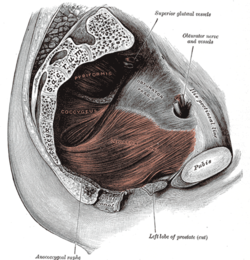Obturator fascia
| Obturator fascia | |
|---|---|
 Coronal section of pelvis, showing arrangement of fasciæ. Viewed from behind. | |
 Left Levator ani from within. (Obturator fascia visible at upper right.) | |
| Details | |
| Identifiers | |
| Latin | fascia obturatoria |
| TA98 | A04.5.03.009 |
| TA2 | 2432 |
| FMA | 19132 |
| Anatomical terminology | |
Theobturator fascia,orfascia of theinternal obturator muscle,covers the pelvic surface of that muscle and is attached around the margin of its origin.
Above, it is loosely connected to the back part of thearcuate line,and here it is continuous with theiliac fascia.
In front of this, as it follows the line of origin of theinternal obturator,it gradually separates from the iliac fascia and the continuity between the two is retained only through theperiosteum.
It arches beneath the obturator vessels and nerve, completing theobturator canal,and at the front of the pelvis is attached to the back of thesuperior ramusof thepubis.
Below, the obturator fascia is attached to thefalciform processof thesacrotuberous ligamentand to thepubic arch,where it becomes continuous with the superior fascia of theurogenital diaphragm.
Behind, it is prolonged into theglutealregion.
The internal pudendal vessels andpudendal nervecross the pelvic surface of the internal obturator and are enclosed in a special canal—Alcock's canal—formed by the obturator fascia.
Theiliococcygeusportion of thelevator aniattaches to the lateral walls of the pelvis via the obturator fascia through the tendinous arch of the obturator fascia.
References
[edit]![]() This article incorporates text in thepublic domainfrompage 420of the 20th edition ofGray's Anatomy(1918)
This article incorporates text in thepublic domainfrompage 420of the 20th edition ofGray's Anatomy(1918)
External links
[edit]- Anatomy photo:42:st-0900at the SUNY Downstate Medical Center
- Anatomy image:9076at the SUNY Downstate Medical Center
- Anatomy image:9873at the SUNY Downstate Medical Center
